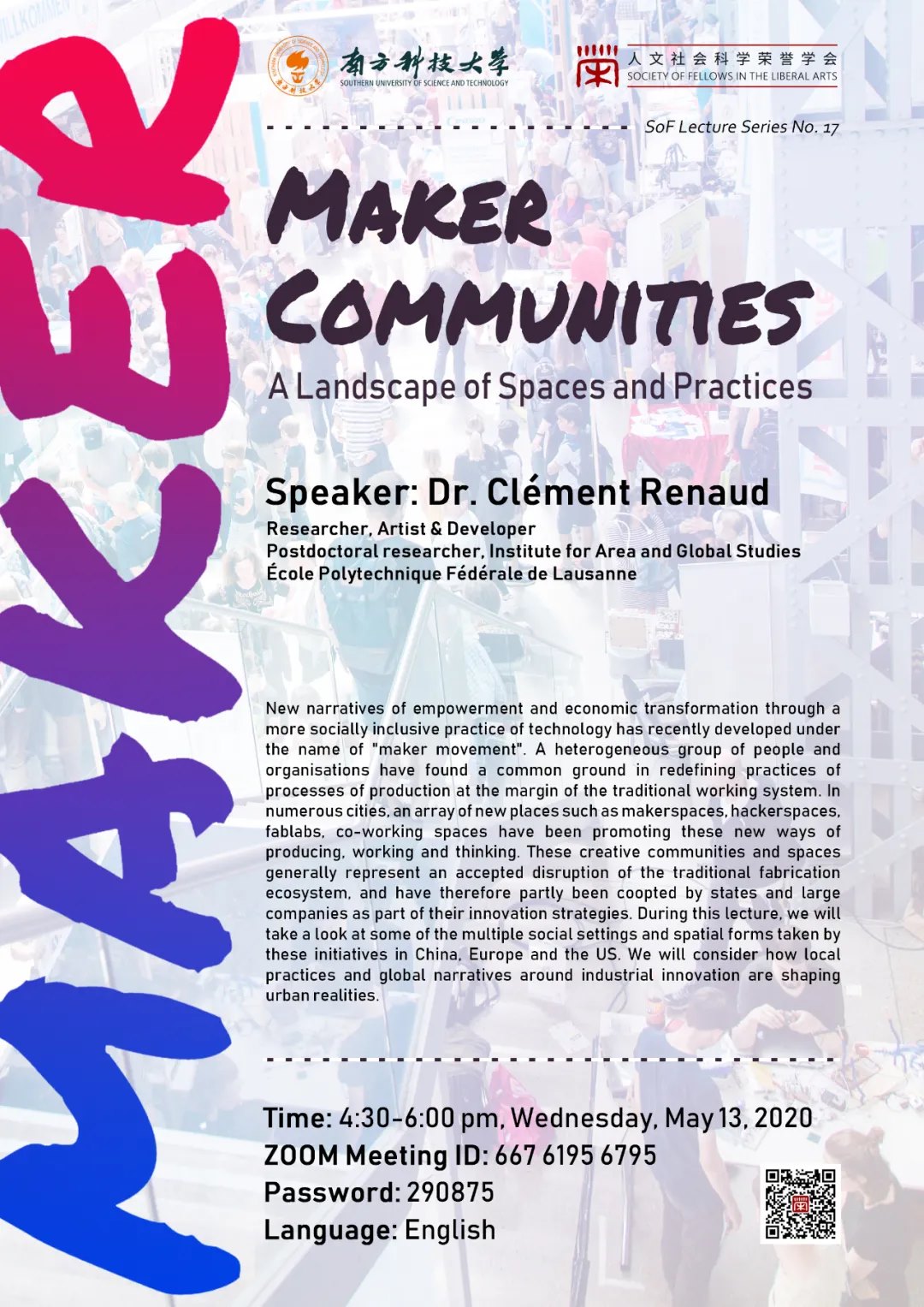Observing Shenzhen: one-day fieldwork practice
A one-day workshop to explore Shenzhen with students of Master of Arts Creative Media at School of Creative Media of City University of Hong Kong.
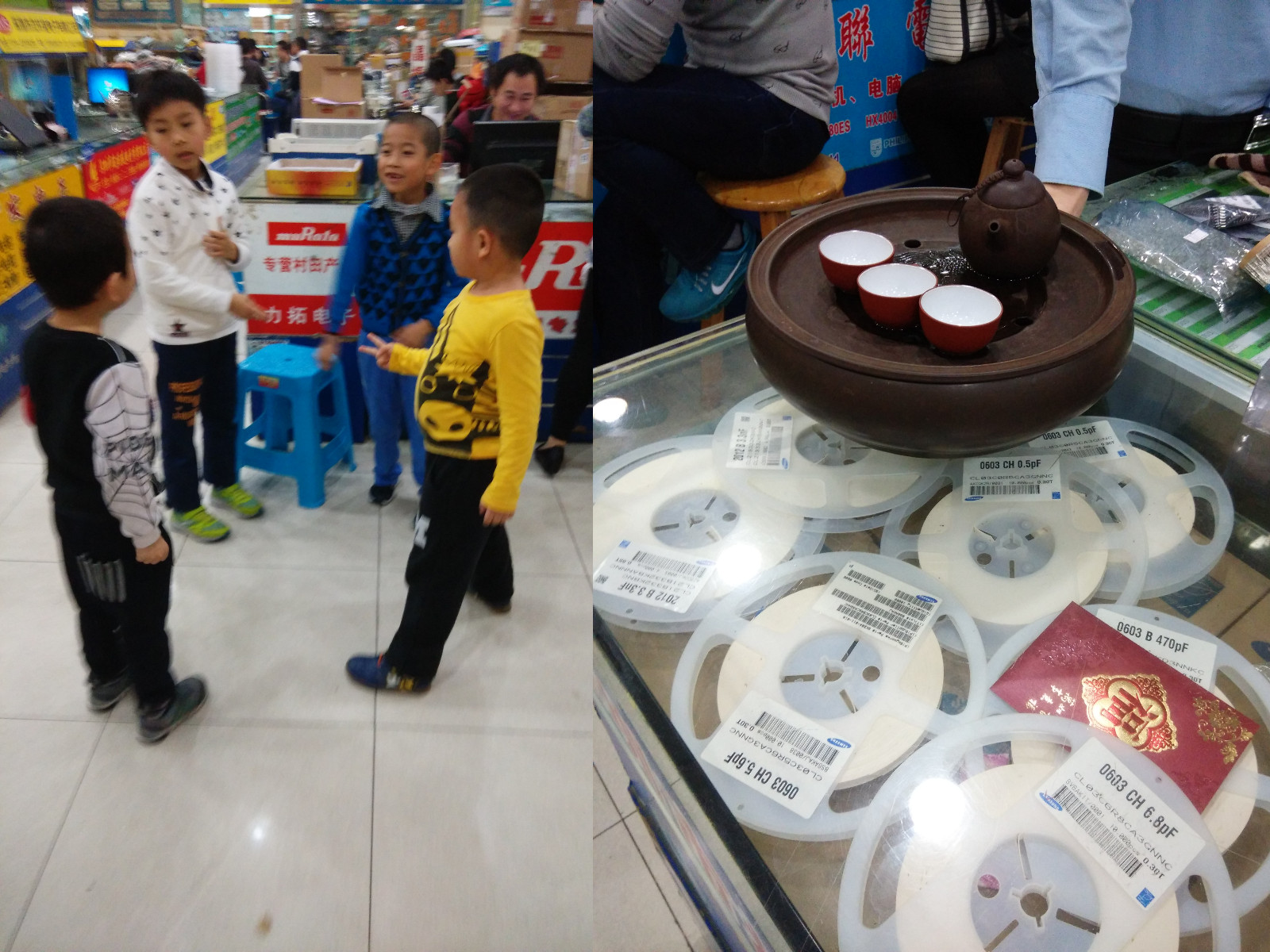
When
20 Feb 2025 - 10am-5pm
Where
Futian District, Shenzhen
What we will do
This field trip will begin at the “Blue Bookstore”, the new permanent space of the UABB Biennale in Shenzhen, and initiate an unplanned journey or dérive through various undisclosed locations in Shenzhen. The tour is an exploration of the socio-technological landscape of Shenzhen through a hands-on exercise on fieldnote-taking and urban observation. Participants are invited to follow the prompts and fieldnote exercises in Nicolas Nova’s Exercices d’observation
Schedule
- 10:30am : meet at 蓝书坊 xUABB 城市驿站 广东省深圳市福田区景田北三街 56 号景蜜公园内
- 11am intro / presentation of the work
- 12am: fieldwork starts - head to 华强北 (huaqiangbei)
- 3pm: meet / debrief at the cafe in Huaqiangbei Museum - 福田区华强北路 1058 号华强北现代之窗大厦五楼 - F5, Huaqiangbei Xiandaizhichuang Building, 1058 Huaqiangbei Road, Futian District - Metro: Line 2 to Huaqiang North Station (华强北站), Exit E2
- 4pm head back to hk
Who
Organized by
Clément Renaud, Dino Zhang, Dennis De Bel, Damien Charrieras
Participants
Students from Master of Arts Creative Media
How
- read the instructions
- pick one/two exercices to practice
- submit your observation using this form
Related readings
Nova, Nicolas. Observation Exercises. Paris, Premier Parallèle, coll. “Parallel Notebooks / the life of things”, 2022
Renaud, Clément. “Global Entanglements in Digital Territories. The Huaqiangbei District in Shenzhen.” Cities and Digital Technology. Paris: Sciences Po, 2023. link.
O’Donnell, Mary Ann. “From Bamboo Curtain to the Silicon Valley of Hardware.” E-Flux, August 2020. link.
Wang, Yifan, and Changwen Chen. “The Unauthorized Repair of the World - Journal #146.” E-Flux, no. 146 (June 2024). link.
De Bel, Roscam-Abbing (2014). Tales From The Vapourtrail, R&D: A Low End Rich Media Publication, p124-147. link
De Bel. “The Ghosts of Shenzhen” REALTIME: Making Digital China, edited by Clément Renaud, Florence Graezer Bideau & Marc Laperrouza, EPFL Press, 2022. link
International call for noticing exercices on February 8, 2025
To understand, we first need to observe. Sitting still or walking around, we start paying attention to our surroundings. Then slowly the magic happen. We start noticing details, patterns, tensions. Ideas form in our heads. We suddenly find ourselves in the midst of creating knowledge, directly from experience.
On a sidewalk in China or in front of a screen, to observe the world has been my favorite activity. Far from a distraction, it acts as a form of meditation where I can abstract myself away and just be there with all the other people and things.
The difficulty lies in that to pay attention about what is happening around, you have to care first. It requires you to ignore whatever important things you are busy with to focus on some random things that happen to be there. Noticing things comes from the practice of caring about what is around you.
While it may look easy, very few people had elevated it as an art like Nicolas did. He excelled at noticing the interesting. His passion for observing the world was incredibly communicative. For those who knew him, they can attest he always cared deeply about the people and things around him. To me, the quality of his observations was only one of the manifestations of his character and show how much he loved to engage with our world.
His short book « Exercises d’Observation » that he left us before his sudden death is a gift for everyone who wants to practice this subtle way of being into the world. It may even act as a guide for those who decide to look for amazement in everyday life. You can train your eyes, you ears and your brain to see the world differently. Despite the dark times we seem to live in, there is still so much about the world to discover and enjoy - but you have to look for it.
As a tribute to Nicolas’ work, we put together with Matthieu Duperrex and Amélie Petit a website to collect everyone’s « exercices d’observation » from all over the world during this weekend. The website will be open to contributions on Friday, as a weekend of celebrations in Nicolas’ memory is happening in Paris. Wherever you happen to be, feel free to join and share your observations and a moment of thoughts for him and our world he loved so much.
https://noticing.world
hashtag#NovaNoticing
'Reputation in anonymous contexts' report for UniRep / Ethereum Foundation
Last year, I worked with Gabriele de Seta and Dino Ge Zhang on a report for the Privacy + Scaling Explorations team at the Ethereum Foundaton. The project was lead by the Unirep crew that was developing a Zero-Knowledge Protocol for Provable User Data Management (per their own words).
UniRep is a private and non-repudiable data system. Users can receive attestations from attesters, and voluntarily prove facts about their data without revealing the data itself. Moreover, users cannot refuse to receive attestations from an attester.
The Unirep project seems dead atm but the report was the opportunity to probe the question of reputation, and on my side to investigate more in details how China’s Social Credit System works in that regard.
Below some more info and the full report availabe for download.
Abstract
This document discusses the relationship between anonymity and reputation in online communities, with case studies from 4chan and Reddit, as well as Japan’s 2ch and China’s Social Credit System. The author argues that design decisions about anonymity and reputation need to take into account users’ elasticity and cultural contexts, and recommends mapping continuums instead of binaries, accounting for elasticity, questioning universality, providing flexible ways to enforce rules, and prioritizing interoperability. The document also provides references for further reading.
Table of Contents
- Executive Summary 3
- Introduction 4
- Approach & Methodology 4
- Definitions: Anonymity & reputation 5 4.1. What is anonymity? 5 4.1.1. Why is anonymity important? 6 4.1.2. Behavioral and social effects of anonymity 6 4.1.3. Anonymity and ICTs 7 4.2. What is reputation? 7 4.2.1. How is it related to fame or popularity? 8 4.2.2. Relationships with trust 8 4.3. Summary 8 4.4. Takeaways 9
- Case Studies: Anonymity & reputation in context 9 5.1. Early online communities in the United States 9 5.2. 2000s forums (4chan reddit) 10 5.2.1. 4chan 10 5.2.2. Reddit 11 5.3. Early internet communities in East Asia 12 5.3.1. 2Channel 13 5.3.2. Nimingban: a facade of anonymity 14 5.4. China’s Social Credit System 14 5.4.1. The SCS Data Platform 15 5.4.2. Mechanisms and Regulatory Systems 16 5.5. Takeaways 17
- Recommendations: 17
- References 18
Takeaways
- The report explores the concept of reputation in an anonymous social environment online.
- The report is divided into three sections: definitions, case studies, and recommendations.
- The research is conducted by a group of three social scientists and the Unirep Protocol team.
- The definitions section lays the groundwork for the report by defining anonymity and reputation and discussing their relationship to trust.
- The case studies section uses a case study approach to illustrate how anonymity and reputation changed through history and in different global contexts.
- The recommendations section provides practical design knowledge derived from the history and discussion.
- The recommendations include: mapping continuums instead of binaries, accounting for elasticity, questioning universality, providing flexible ways to enforce rules, and prioritizing interoperability.
- The report suggests that reputation in an anonymous social environment online is a complex and nuanced concept that requires careful consideration and flexible design
New working paper about global history of computer seen from Shenzhen, China
The working paper is entitled: “Global entanglements in digital territories. The Huaqiangbei district in Shenzhen” and was published by The “Cities and Digital Technology* Chair of Sciences Po’s Urban School.
Abstract
This paper consider the recent history of personal computing as seen from the district of Huaqiangbei (华强北) in the city of Shenzhen, China. Part of the original design of China’s first Special Economic Zone, this area stands at the crossroad of two major global transformations : the raise of digital technology worldwide and the return of China at a main actor of the global economy. The paper provides an overview of the spatial history, industry and culture in the area known today as Huaqiangbei by following successive generations of consumer electronics such as whitebox computers of the 1990s/2000s, the mobile phones of 2000s/2010s and the integration of Internet into numerous objects around 2010s, often known as the Internet of Things. From an original state-owned factory, to a central hub in global electronics manufacturing to one of the flagship of China’s innovation policy today, the spatial history of this district demonstrates the prominent role played by local actors such as China policy makers or factory workers in shaping the digital world as we know it.
Keywords
Shenzhen, Huaqiangbei, cultural practices, computer culture, computer history, electronics manufacturing, DIY movement, spatial analysis, urban policy
Special thanks to Florence Graezer-Bideau and Mac Laperrouza for all the inputs, ideas and discussions. Thanks to Antoine Courmont for the support and careful reviews and Mary Ann O’Donnel for the discussions.
Abrégé de mythologie numérique chinoise
Le 21 février 2023, je présenterai dans le cadre du séminaire MIG organisé par RYBN un texte initulé Mythologie numérique chinoise sur lequel je travaille actuellement. La discussion aura lieu à la Générale à Paris sur les coups de 19h. Comme à l’accoutumée, la séance sera radiodiffusée puis archivée sur le site du MIG.
Présentation
Depuis des siècles, la Chine n’a cessé d’alimenter l’imaginaire sulfureux des salons occidentaux. Mais si l’orientaliste du 19e aimait enfermer la Chine dans son passé supposé éternel, celui du 21e préfère la cantonner à un futur aussi dystopique qu’inéluctable.
Véritable père fouettard des réseaux, la Chine incarne aujourd’hui une figure despotique et terrifiante. Reflet exagéré des fantasmes morbides de l’Occident, cette image persistante occulte pourtant les innombrables pratiques et objets numériques qui foisonnent dans cet immense pays. Usines-villages, petits pingouins ou immenses chantiers, l’abondante mythologie qui façonne le monde numérique chinois reste aujourd’hui largement méconnue.
Au cours de cette discussion, je présenterai quelques-uns des mythes fondateurs du numérique en Chine comme autant de jalons d’une chronologie historique, politique et sociale qui s’étend bien au-delà des frontières chinoises. Nous nous éloignerons un temps des récits californiens pour contempler un autre chapitre majeur de l’histoire des technologies de notre quotidien.
Bio
Clément Renaud vit et travaille comme chercheur, développeur et écrivain entre la Chine, les États Unis et l’Europe depuis plus de 15 ans. Il a notamment édité le livre REALTIME : Making Digital China paru en 2020 aux presses de l’EPFL. Les éléments de cette discussion sont issus d’un article intitulé Mythologie numérique chinoise en cours de rédaction (disponible sur demande à bonjour@clementrenaud.com )
Liens
- Site du MIG: Séminaire informel et extra-disciplinaire. Technologies, écologies, politiques. Tous les mardis à la Générale, Paris.
SHAPES2048
Looking back after 1 year of SLASHES
by Clément Renaud & Makio135
makio135.com/shapes
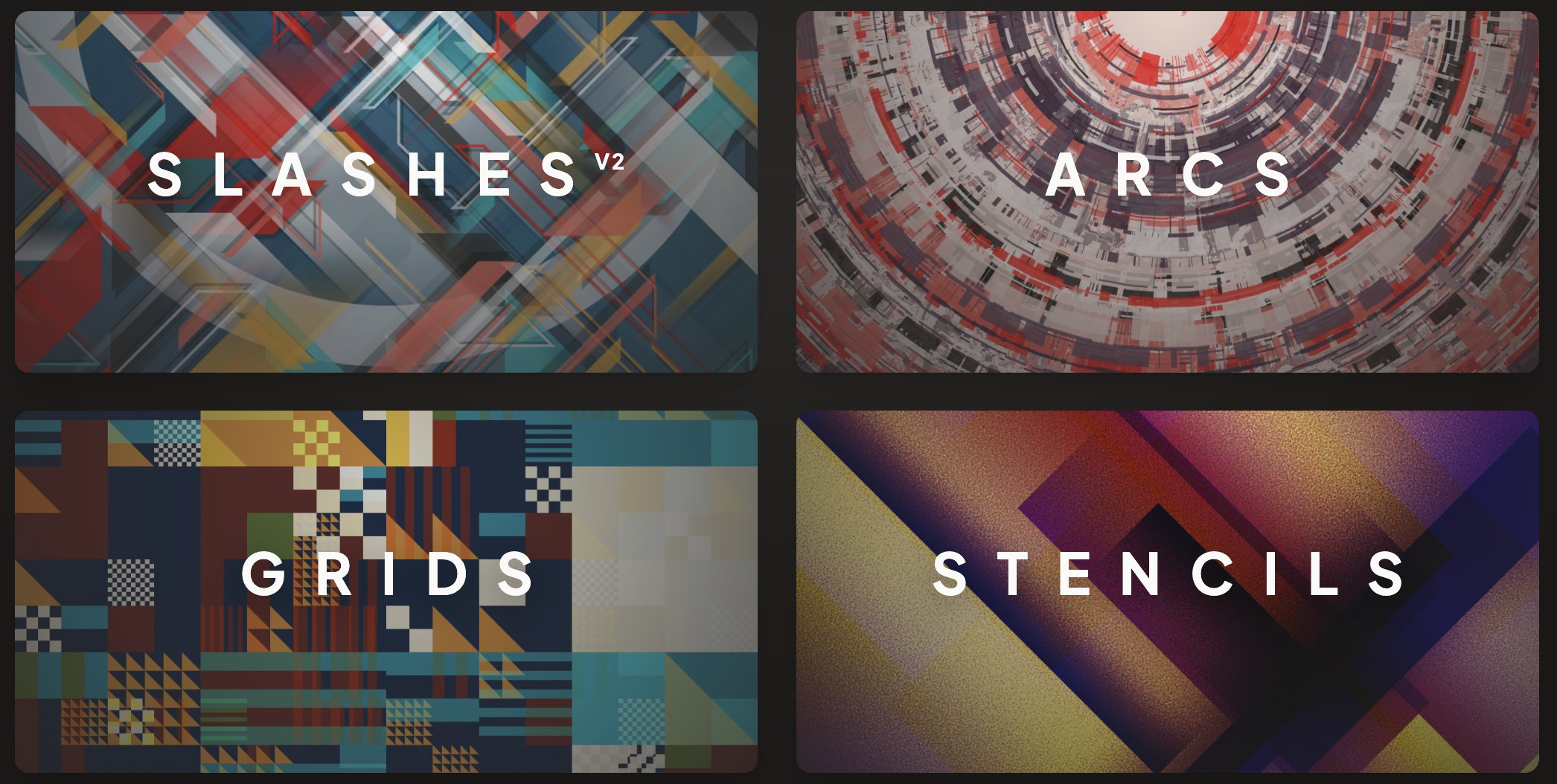
Today marks the first anniversary of SLASHES. The collaboration between generative artist @Makio135 and creative developer @clemsos was meant to be a simple experiment to draw images using the Ethereum Virtual Machine. Its success (and failures) led to a larger project called SHAPES2048 that explores further the interactions between graphics, generation, curation and contract features.
Drawing contracts
Habits of torturing machines to create images die hard. When we first heard that there was a new “global computer” called Ethereum, we started to form ideas about how to use it for drawing. We made various attempts at rendering simple vector graphics using contracts. Finally, we decided that we may actually want to generate complex geometry and colors entirely within a single Ethereum contract call, without relying on any external source or web server. This approach - since popularized as in-chain rendering1 - had also the benefits of preventing images from going missing.
Working with all kinds of machines over the years, we perfected the craft of developing our own tools. We approached SLASHES by first draw an image in a text editor and then convert it to a contract. We started with a familiar shape - the slash - and built up the generator plus the required tooling, viewer, NFT contract, website, etc. The initial feedback for the release was so fantastic and overwhelming (more on that later) that we decided to continue to perfect our toolkit with a new project called SHAPES2048.
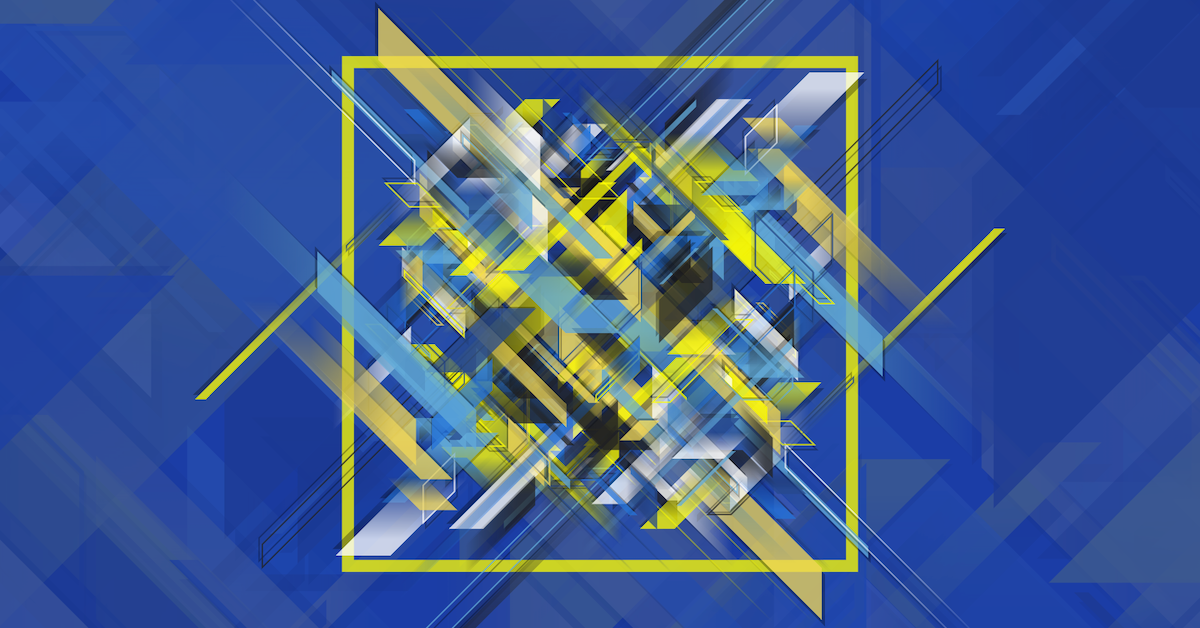
Along the way, we discovered more efficient techniques. They greatly improved the complexity and details of the graphics - while allowing us to stay within the sacrosanct gas limits of Ethereum. Instead of a single shape, the SHAPES project grew to include four different generators (Slashes V2, Arc, Grids and Stencils). Each of them being able to create unique pieces with each their own texture, appearance and features based on a single shape.
Contributive curation
Randomness brings beauty to generative art - but also frustration. The same algorithm often produces some pieces that really stand out. On the other hand, there are always a bunch of artworks that evolves from a bad seed, leaving the new owner with the unsatisfactory feeling that the algorithm could do better. The definite and “immutable” nature of blockchain technology makes things even worse as you seem often have only one single chance to get it right2.
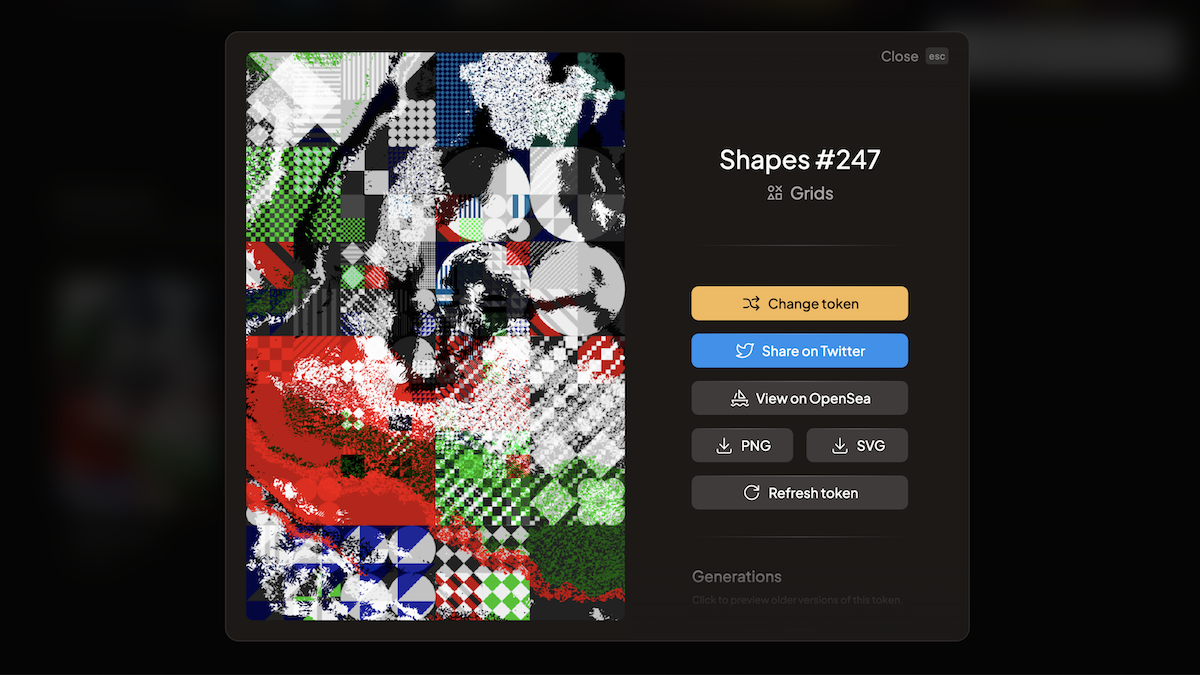
The artist usually wrestles alone with the algorithm, while collectors are left to face the randomness. With SHAPES2048, we decided to join hands by adding in our contract the ability for the holder of any artwork to re-generate the piece any number of times - until the outcome felt satisfying. All versions of a token are kept in the contract, allowing collectors to change their mind and revert to previous attempts. This exploratory process also allows collectors to switch from a shape to another (e.g. from an Arc to a Stencil). Hand-picking the tokens creates a general process of curation for the entire collection, turning into a reflection of the collectors’ actions.
A year in the making
SLASHES was our first experiment with the constraints of the Solidity language and the Ethereum Virtual Machine. We certainly didn’t expect the project to mint out in a few minutes. The experience was so intense3 that we decided to conceive its current successor SHAPES2048. After half a year of existence, SHAPES2048 is now living its own life.
Until today, we have allowed collectors of the original SLASHES to exchange their tokens against newer SHAPES2048 using the contract or the dedicated website. During the next 6 months, you will still be able to participate in SHAPES2048 by minting your token - and picking your favorite version of it. Altogether there is a total of 2048 tokens with an potentially infinite number of variations.
Hope you will enjoy yours!
Thanks to Hugo Sainte-Marie for the help on the UI/UX designer.
For more, see SHAPES official page, SLASHES official page or the SLASHES collection on Opensea.
-
From https://0xchain.art/info : “On-chain because the advantage of having code, artwork and/or metadata on-chain creates permanence and immutability. They are permanently stored on the blockchain as long as the Ethereum network exists. Relying solely on the Ethereum Virtual Machine presents lots of constraints which stimulates creativity.” ↩
-
See this complete analysis of the SLASHES rarity for more on this ↩
-
During the release, we met 2 minor issues: a bug with in the display of the titles and a royalty fee considered too high (originally 15%, now 7%) by the herd of flippers that started to immediately dump the project minutes after its release. ↩
COBOL Blues
Depuis sa conception à la fin des années 50, le language de programmation COBOL continue de régner en maître sur l’infrastructure mondiale. Frais bancaires, envois de containers, données médicales, connections téléphoniques, prélèvement de taxes, primes d’assurances, ou encore l’intégralité des transactions Visa : les petites choses de la vie passent par un script COBOL. Plusieurs décennies de performances inégalées l’ont amené à littéralement dominer le calcul. Et pourtant, les managers continuent de s’arracher les cheveux.
Le “Cobol Blues”
La pénurie fait rage, et le programmeur COBOL reste une espèce en voie de disparition et qui se monnaye au prix fort. Les “cow-boys” qui ont conçus ces systèmes sont depuis longtemps à la retraite, alors que les “youngsters” approchent la cinquantaine. La pandémie de COVID19 bouleverse les infrastructures mondiales, et met le personnel exécutif des Fortune 500 face aux réalités du “COBOL Blues”.
Hormis l’Inde qui continue de former de jeunes diplômés, il semblerait que le COBOL est disparu des programmes d’enseignement universitaire quelque part au milieu des années 80. La demande en “software engineers” capables de programmer les PCs fraichement arrivés a éclipsé l’intérêt pour les “mainframes” (ordinateur central en français), terrain de jeu préféré des programmes COBOL.
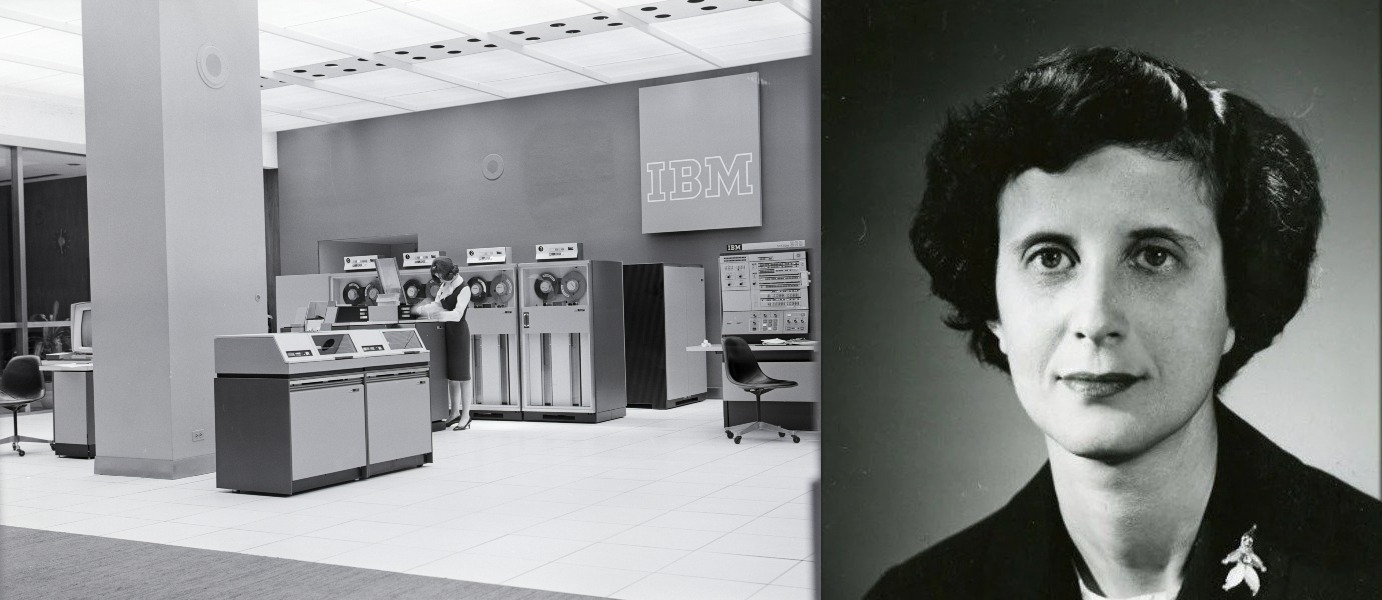
A gauche : IBM mainframe dans les années 1960s (photo : Bettmann Archive) / A droite: Jean E. Sammet mène la création de COBOL comme consultante pour le Pentagone entre Juin et Novembre 1959, avant de rejoindre IBM en 1961 (photo: IBM Archive)
Histoires comptables
Un article de 2018 intitulé Is COBOL holding you hostage with Math? (découvert dans la newsletter de l’ami Nicolas Nova) explique comment COBOL est finalement plus performant. La manière dont COBOL arrondit les chiffres décimaux (fixed point) lui permet d’être plus exact à n chiffres après la virgule. La plupart des autres languages utilise l’arrondi par floating point, plus approximatif - voir cette réponse Stack Overflow. Néanmoins, depuis 2014, COBOL utilise lui aussi l’arrondi par floating point - grâce au récent standard IEEE. L’utilisation du fixed point était essentiellement lié à la présence d’instructions machines spécifiques dans les mainframe IBM. Aujourd’hui, les limitations de calculs se situent plutôt côté hardware (coucou les cypto-monnaies).
IDENTIFICATION DIVISION.
PROGRAM-ID. HELLO.
DATA DIVISION.
WORKING-STORAGE SECTION.
01 WS-NUM1 PIC 99V9 VALUE IS 3.5.
01 WS-NAME PIC A(6) VALUE 'ABCD'.
01 WS-ID PIC 99 VALUE ZERO.
PROCEDURE DIVISION.
DISPLAY "WS-NUM1 : "WS-NUM1.
DISPLAY "WS-NAME : "WS-NAME.
DISPLAY "WS-ID : "WS-ID.
STOP RUN.
---
output:
// WS-NUM1 : 03.5
// WS-NAME : ABCD
// WS-ID : 00
Pourquoi s’obstiner?
Mais pourquoi s’entêter à utiliser un langage désuet comme COBOL alors qu’il existe pléthore de très bonnes solutions? L’inertie manageriale et la “peur du changement” des géants industriels est souvent invoquée. A vrai dire, se frotter à des systèmes si complexes ferait frémir même la plus téméraire armée de consultants en conduite du changement. Véritable sur-couche administrative, ces immenses châteaux de cartes perforées contiennent des décennies d’instructions propres aux régulations financières, douanières ou que sais-je encore. Nul ne peut s’aventurer dans la réécriture de milliards de lignes de code sans transformer profondément le fonctionnement et le sens du “système”.
Pourtant, l’image qu’on pourrait avoir de programmes monolithiques n’ayant pas bougé depuis 50 ans est largement fausse. La plupart des outils COBOL sont activement maintenus. Le language continue d’être mis à jour. Les opérations de maintenance sont légions. Néanmoins, tout ceci ne fait qu’accroitre la dépendance au système actuel, sans addresser pour autant la question de son devenir. L’appareil COBOL, loin d’être un archaïsme, régit nos interactions quotidiennes via plusieurs des grands systèmes d’échange mondiaux. Le manque de pilotes à bord n’est pas une question technologique, mais plutôt un symptôme général de l’état de ces organisations.
Inventeur de la touche escape présente sur tous les ordinateurs de la planète, Robert «Bob» Bemer travaille avec Grace Hopper sur le cobol. «D’un certain point de vue, je suis responsable du bug de l’an 2000», dit-il aujourd’hui, à 79 ans. Son erreur? N’avoir imposé aucune norme pour coder les dates dans le cobol.
“Genèse et chronique du bug de l’an 2000 depuis 1945.”, dans Libération du 31 décembre 1999.
Esthétique décadente
Personnellement, je soupçonne qu’une partie des calculs continuent de s’écrire en COBOL car cela se lit bien si on connaît Excel. Un programme COBOL, ce sont grosso modo des formules Excel qui tournent sur un énorme ordinateur. Aucun comptable sain d’esprit ne déléguera 100% de sa compétence d’écriture à des programmeurs, et encore moins s’il est VP d’une compagnie d’assurance ou de la Fed. La syntaxe COBOL permet aux pros du tableurs d’auditer les calculs facilement. Plus simplement en tout cas qu’un language de programmation fonctionnelle hipster, avec des notations du genre const uint16_t keymaps[][2][3]::unit32_t.
Finalement, COBOL continue de dominer le monde “corporate” occidental car c’est le langage parfait pour en exprimer les opérations. Un reliquat de l’aprés-guerre, ultra-conservateur, indéboulonnable, inventé au Pentagone, pas expressif pour un sou, obsédé par le nième chiffre après la virgule et qui continue de faire tourner le monde - sans que personne ne comprenne trop comment.
Tout ça pour dire, qu’on gagnerait à considérer les langages informatiques comme des allégories, plutôt que de s’embarrasser de considérations managériales. Cela permettrait de d’affranchir 5 minutes des discours d’escortes sur les “technologies”, et de considérer l’immense contribution de ces écritures aux cultures modernes, voire même d’apprendre un truc ou deux sur elles.
PM Lee addresses and the post-colonial legacy of leadership
I just read this article in Foreign Policy by Singapore Prime Minister about the threat of US-China crossfire for Asian countries.
As expected, this is a very conservative and consensual take. Still, it struck me that a head of state can actually express his world views in such a clear and articulate writing. I remember watching his covid19 address in February and thinking it was an act of class too. I almost forgot prime ministers could write and speak clearly!
Like his father, PM Lee personifies the highly-educated, post-colonial, global leadership with his subtle mix of no-nonsense claims, financial greed, military expertise, and British manners. Interestingly, such profiles seem to be disappearing from the European and US political sphere but are now very present in Asia.
Not to say that this old-fashioned reactionary leaders are any good for Asian countries. But writing more than three structured sentences in a row without contradicting oneself sounds like a good requirement to govern.
La science n'est pas une communauté d'opinions
NB: J’ai écris ce commentaire en réponse à un article paru dans AOC Media - Urgence thérapeutique, controverses et production de la preuve dans l’espace public – à propos de l’hydroxychloroquine (derrière paywall) dont voici un extrait :
“Si l’on résume ce dont Didier Raoult est le nom, c’est le fait que l’espace public devient un espace quelque peu fracturé, où coexistent des communautés d’opinions sur la science, qui fabriquent la connaissance qu’elles considèrent comme crédibles selon des critères distincts.”
Cet article présente une discussion de bon ton dans l’académie, mais rate à mon sens une question épistémologique plus centrale : la science serait-t-elle également une communauté d’opinions?
Alors que La “science” - les citations en italique issues de l’article original - est bien la première à se tailler sur mesure ses petits “régimes de véracité” qui l’arrangent autour d’une “mosaïque” de “communautés d’opinions” - que les auteurs voient plutôt dans un “espace public” bizarrement.
Personnellement, je trouve un peu fatigant ces éditos de scientifiques qui arrivent à se dédouaner en parlant de numérique, de politique et finissent par mettre les problèmes sur le dos de l’urgence, pour conclure “Cette situation devrait conduire à inventer des moyens qui permettent…”
Quelle situation exactement? Les conflits entre modélisation et empirie (ici épidémio/clinique)? L’absence de discussions entre disciplines? Le fait qu’au bout de 100 ans on en soit encore à demander “alors tu fais plutôt du quali ou du quanti”? Le fait qu’un type dans un labo marseillais est une dizaine de milliers de citations et concentre ainsi une autorité disproportionnée? Ou alors peut-être le fait que les serveurs pre-print comme Medrvix ressemblent étrangement à ma boîte de spam aujourd’hui?
Et si ce dont Didier Raoult était le nom justement, c’était de l’incurie avec laquelle les “scientifiques” traitent la connaissance ? On en parle quand de l’inadéquation des processus de la recherche aux réalités du monde actuel? des citadelles de chercheurs défendant leurs petites méthodes-calculettes, des publications désuettes, de la hiérarchie quasi médiévale, des pratiques de travail d’un autre temps, du mépris pour la communication scientifique, etc?
Non, congratulons-nous plutôt de “la réussite de la communauté scientifique face à sras-cov-2” en espérant que tout cela regonfle un peu le budget recherche du ministère l’an prochain. Ca permettra de payer 2-3 doctorants pour faire avancer un quelconque projet administratif de prestige pour le labo.
La science a le beau rôle, mais j’aimerai bien un peu plus d’introspection parfois… “A blind spot bigger than the sun” comme on dit. L’urgence créée par covid19 ne fait que révéler des dysfonctionnements bien plus profonds de la société dont la science est partie intégrante.
Pour les scientifiques, l’urgence est, il me semble, de considérer leurs rôles dans ce qui disfonctionne aujourd’hui pour continuer à réinventer leurs pratiques.
'Maker Communities: A Landscape of Spaces and Practices' - a lecture at Shenzhen University of Science and Technology
Hi there, for those interested about the spaces and practices of the “makers”, I am giving a public lecture (online) tomorrow for the Society of Fellows in the Liberal Arts at Shenzhen University of Science and Technology.
创客社区:空间与实践
Maker Communities: A Landscape of Spaces and Practices
讲座摘要 ABSTRACT
通过更具社会包容性的技术实践,新的权力赋予和经济转型的叙事近年来以“创客运动”的名义发展起来。在传统工作体系的边缘,各种各样的人和组织在重新定义生产过程的实践中找到了共同的兴趣和目标。在许多城市中,诸如创客空间、黑客空间、自造实验室和联合工作空间等一系列新场所在不断地推动传播这种新的生产、工作和思考方式。这些创意社区和空间通常代表着对传统生产生态系统的扰乱。因此,一些国家和大公司将其吸纳为自身创新策略的一部分。在本讲座中,我们将介绍在中国、欧洲和美国,这些行为产生的多元社会环境和采取的多样空间形式。我们将考虑工业创新的本地实践和全球叙事如何塑造了城市的现实。
New narratives of empowerment and economic transformation through a more socially inclusive practice of technology has recently developed under the name of “maker movement”. A heterogeneous group of people and organisations have found a common ground in redefining processes of production at the margin of the traditional working system. In numerous cities, an array of new places such as makerspaces, hackerspaces, fablabs, co-working spaces have been promoting these new ways of producing, working and thinking. These creative communities and spaces generally represent an accepted disruption of the traditional fabrication ecosystem, and have therefore partly been coopted by states and large companies as part of their innovation strategies. During this lecture, we will take a look at some of the multiple social settings and spatial forms taken by these initiatives in China, Europe and the US. By doing so, we will consider how local practices and global narratives around industrial innovation are shaping urban realities.
主讲人 SPEAKER
Clément Renaud 博士
主讲人Clément Renaud 博士是法国人,在法国高等电信学校获得管理与信息系统的博士学位,现在任职于瑞士洛桑联邦理工学院、法国里昂高等师范学院等欧洲研究机构。Clément Renaud 博士是活跃在欧洲和中国的知名城市研究学者以及数码艺术家,其研究融汇媒体、数字创意设计、城市研究等多个学科领域,通过创意艺术、民族志、基于实践的研究等形式,揭示不同语境下当代城市生活的多样性与可能性。
Dr. Clément Renaud
Dr. Clément Renaud obtained his PhD in Management and Information Systems from Telecom ParisTech. He is now taking multiple positions in European research institutions, including a Postdoctoral Fellowship at École Polytechnique Fédérale de Lausanne in Switzerland and a Research Engineer position at ENS de Lyon. Dr. Clément Renaud is also an active digital artist and urban researcher based in Europe and China. Integrating creative digital media, ethnography, and action-based research methods, Dr. Clément Renaud’s work contributes a sharp observation of how we perceive and experience contemporary urban environments and lives in various local contexts across the world.
讲座信息 INFORMATION
时间:2020年5月13日(周三)16:30-18:00 网上课堂ZOOM会议号:667 6195 6795,密码:290875 主讲语言:英语 主办:南方科技大学人文社会科学荣誉学会
Time: May 13, 2020 (Wednesday), 16:30-18:00
Online ZOOM Meeting ID: 667 6195 6795 Password: 290875
Language: English
Host: Society of Fellows in the Liberal Arts, SUSTech
